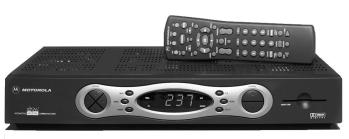New joint venture will support Motorola Linux-based TV STB
Jan 7, 2002 — by LinuxDevices Staff — from the LinuxDevices Archive — 6 viewsSalt Lake City; Austin, Texas; and Horsham PA — Lineo, Metrowerks, and Motorola's Broadband Communications Sector announced today that they have formed a joint venture called Triarc Content Labs. The venture will facilitate the design and development of Linux-based, advanced-interactive television software applications on Motorola's DCT5000 family of advanced-interactive digital set-tops.

Motorola's DCT5000 set-top box
Contributing to the joint venture, Lineo will provide its Lineo Embedix Digital Media core, an embedded Linux system software platform; Metrowerks will supply CodeWarrior development tools; Motorola, in addition to its DCT5000 family running the Embedix platform, will also provide its expertise in advanced-interactive digital cable technology, systems integration, and deployment.
The companies are forming Triarc Content Labs to provide the broadband industry with an independent source for development, testing and integration of Linux-based content and applications. This resource is expected to speed time-to-market of new and interactive services such as pay-per-view (PPV), video-on-demand (VOD), games, Web browsers, program guides, personal video recorders (PVR), home networking and streaming media.
This announcement follows the broadband cable industry's June 2001 formation of the TV Linux Alliance — of which Motorola and Lineo are founding members — to define a standards-based Linux environment for the digital set-top market. The Linux environment offers broadband network operators significant benefits including lower operating system and development costs, more rapid device driver support for new hardware features, fewer repeated tasks in porting middleware solutions, and easier porting of additional new interactive applications. Triarc Content Labs will work in concert with Motorola's Horizon Program and Acadia Labs for applications destined for Motorola platforms.
Triarc Content Labs will offer an environment equipped with the latest digital headend systems and will be built to emulate and replicate highly scalable, two-way digital cable plants.
Triarc Content Labs is expected to be operational in mid 2002. Additional information about Triarc Content Labs and availability of products and support will be released later this month. Customers interested in receiving immediate information may send an email to [email protected].
“Motorola is committed to providing resources that help independent software vendors develop and deploy digital solutions more rapidly, which will lead to more wide scale deployment of the DCT5000 platform,” said Carl McGrath, vice president and general manager for Motorola Broadband. “This joint venture, following the formation of the TV Linux Alliance and our recently announced development agreement with Lineo, marks the third phase of our strategy to spur development and adoption of Linux-based content and applications.”
About Motorola's DCT5000 Family
Among the most technologically advanced interactive set-tops available today, Motorola's DCT5000 family — which includes the DCT5000, the DCT5100, and the DCT5200 series — offers an advanced interactive platform with integrated high-speed cable modem, high performance processing, and graphics. This platform provides operators with robust support for more demanding network and client intensive interactivity. Each member of the DCT5000 family contains a high-end processor, expanded memory footprint, high-end graphics, and an integrated DOCSIS cable modem to run advanced-interactive application suites and deliver Web-enhanced interactivity. Each of these advanced-interactive set-tops also offers a standard integrated High-Definition decoder to offer an economical means for operators to address the growing HD market. In addition to enabling core interactive features such as electronic program guides (EPGs), pay-per-view (PPV), video-on-demand (VOD), the DCT5000 family of set-tops provide a platform for future IP and video-based interactivity, including PVR, streaming media, high-speed Web browsing, IP and video telephony, file transfer capability, session-oriented gaming, and advanced middleware suites.
This article was originally published on LinuxDevices.com and has been donated to the open source community by QuinStreet Inc. Please visit LinuxToday.com for up-to-date news and articles about Linux and open source.